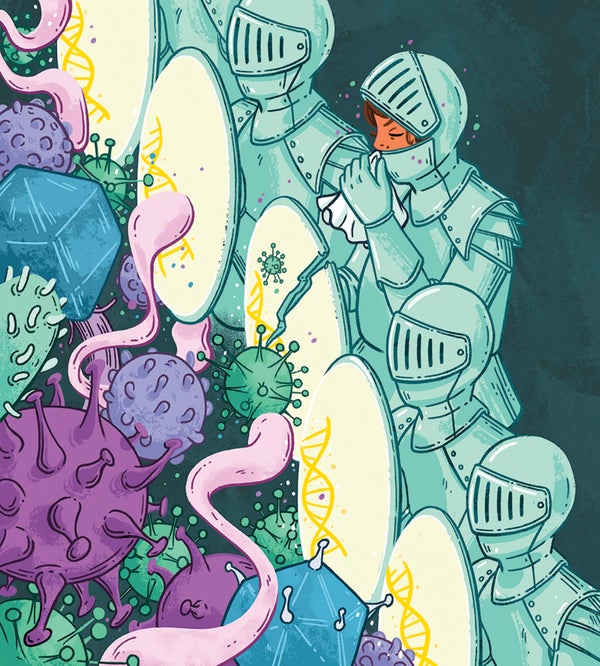Bad luck. Terrible misfortune. That’s what we think when we hear about a perfectly healthy child who suddenly dies of influenza, a virus most of us can shake off. But what if it isn’t luck? What if this kind of deadly infection turns out to be, well, genetic?
Odd as that sounds, there is a growing body of research that supports the idea. Much of it has been led by Jean-Laurent Casanova, a pediatric immunologist and geneticist at the Rockefeller University. Casanova wanted to unravel those tragic cases of flu, in which a child with no apparent underlying illness wound up in the intensive care unit. He was equally intrigued by other infections that are perfectly survivable or even innocuous for most of us but send some people to their grave.
There are many examples of what Casanova calls “the infection enigma.” Herpes simplex viruses, for instance, can cause annoying cold sores and genital lesions in many people, but in rare cases they invade the brain and incite potentially lethal encephalitis. Candida albicans is a ubiquitous fungus that typically causes serious harm only to people with a weakened immune system, and yet some otherwise healthy individuals suffer repeated bouts of infection. Even with a dire disease such as tuberculosis, Casanova notes, in places where the TB bacterium is endemic, “everyone inhales it, but not everyone gets sick, and fewer than one in 100 will die of TB.” This can’t just be the fickle finger of fate, he reasoned.
On supporting science journalism
If you're enjoying this article, consider supporting our award-winning journalism by subscribing. By purchasing a subscription you are helping to ensure the future of impactful stories about the discoveries and ideas shaping our world today.
In some cases, susceptibility to a specific kind of infection—Candida, for example—runs in families. This was Casanova’s big clue. He hypothesized that some of us harbor genetic mutations, whether inherited or spontaneous, that make us susceptible to a particular germ, much the way certain strains of wheat are genetically vulnerable to a particular blight.
Over the past two decades Casanova, often working with Laurent Abel of Necker Hospital for Sick Children in Paris, and a few other laboratories have identified dozens of single-gene mutations causing this kind of vulnerability. These mutations do not devastate defenses. Instead, Casanova explains, “these are pathogen-specific diseases caused by inborn errors of immunity that are very narrow—sometimes [involving] one virus, one bacterium.”
In the case of severe flu, Casanova’s team has identified three gene defects that raise vulnerability, including two that impact interferons. With herpes simplex encephalitis, one category of mutations lays carriers open to infection in the front of the brain. A second type causes vulnerability to encephalitis in the hindbrain. With flu, children eventually develop antibody protection that compensates for the genetic flaw; the same is likely true for herpes.
Most of these mutations are rare, but Casanova’s lab has found a defect that causes vulnerability to TB and is present in one in 600 people of European ancestry and one in 1,000 humans. More recently, Casanova and collaborators have discovered that inborn errors in the functioning of interferons also play a role in increasing vulnerability to COVID.
Taken together, these surprising discoveries are creating a paradigm shift in how we think about severe infection. “This work makes the case that we should shift a little of our attention from the germ to the host, or child,” says Isabelle Meyts, a pediatric immunologist at University Hospitals Leuven in Belgium. The findings also expand our understanding of the human immune system, especially defenses that do not depend on white blood cells, notes immunologist Helen Su of the National Institute of Allergy and Infectious Diseases. There is great redundancy built into our germ-fighting systems, so it is shocking to learn that initial protection from a specific bug can depend on a single gene.
This research suggests that doctors should do genetic workups in puzzling cases of serious infection, Meyts says. The results can sometimes guide treatment. For example, Casanova and others have found more than a dozen mutations that disrupt the body’s ability to battle non-TB mycobacteria, and all of them mess with interferon gamma—a key immune system activator. Giving such patients this interferon “works beautifully,” Casanova says. “It’s like insulin for diabetic patients.”
A genetic analysis could also enable doctors to counsel relatives on who else is at risk. Crucially, families can come to understand that a loved one died of infection because of a flawed gene. “The fact that they have an answer is a tremendous solace,” Su observes.
